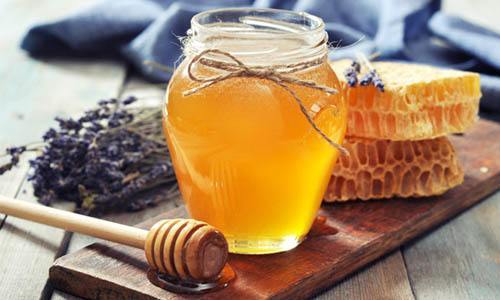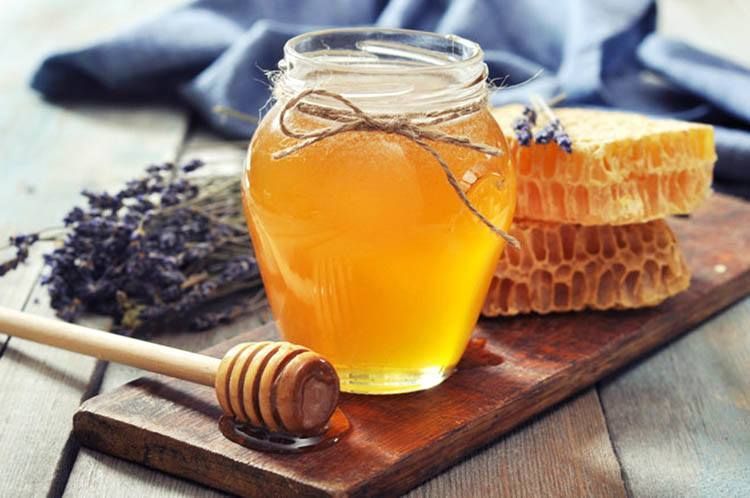

Since ancient times, honey has been used as both a food and a medicine.
It’s very high in beneficial plant compounds and offers several health benefits.
Honey is particularly healthy when used instead of refined sugar, which is 100 percent empty calories.
Here are the top 10 health benefits of honey that are supported by science.
1. Honey Contains Some Nutrients
Honey is a sweet, thick liquid made by honeybees.
The bees swarm their environment and collect the sugar-rich nectar of flowers (1).
Then inside the beehive, they repeatedly consume, digest and regurgitate (“vomit”) the nectar.
The end product is honey, a liquid that is supposed to serve as stored food for the bees. The smell, color and taste depend on the types of flowers the bees visit.
This is what honey typically looks like:

Nutritionally, 1 tablespoon of honey (21 grams) contains 64 calories and 17 grams of sugar, including fructose, glucose, maltose and sucrose.
It contains virtually no fiber, fat or protein (2).
It also contains trace amounts (under 1 percent of RDA) of several vitamins and minerals, but you would have to eat many pounds to fulfill your daily requirements.
Where honey shines is in its content of bioactive plant compounds and antioxidants. Darker types tend to be even higher in these compounds than lighter types (3, 4).
Bottom Line: Honey is thick, sweet liquid made by honeybees. It is low in vitamins and minerals, but may be high in some plant compounds.
2. High-Quality Honey is Rich in Antioxidants
High-quality honey contains many important antioxidants. These includes phenols, enzymes and compounds like flavonoids and organic acids (5).
Scientists believe that it is the combination of these compounds that gives honey its antioxidant power (5).
Interestingly, two studies have shown that buckwheat honey increases the antioxidant value of the blood (6, 7).
Antioxidants have been linked to reduced risk of heart attacks, strokes and some types of cancer. They may also promote eye health (8).
Bottom Line: Honey contains a number of antioxidants, including phenolic compounds like flavonoids.
3. Honey is “Less Bad” Than Sugar For Diabetics
The evidence on honey and diabetes is mixed.
On one hand, it can help with some risk factors that are common in diabetics.
For example, it lowers LDL cholesterol, triglycerides and inflammation and raises HDL (the “good”) cholesterol (9, 10, 11).
However, some studies have found that it can also increase blood sugar levels, just not as much as refined sugar (10).
So, while honey may be “less bad” than refined sugar for diabetics, it is still something that diabetics should only consume with caution.
In fact, diabetics may do best minimizing all high-carb foods (12).
Bottom Line: Some studies show that honey improves heart disease risk factors in diabetics. However, it also raises blood sugar levels, so it can not be considered “diabetic-friendly.”
4. Honey Can Help Lower Blood Pressure
Blood pressure is an important risk factor for heart disease and honey may help lower it.
This is because honey contains antioxidant compounds that have been linked to blood pressure lowering effects (13).
Studies in both rats and humans have shown modest reductions in blood pressure from consuming honey (14, 15).
Bottom Line: Eating honey may lead to modest reductions in blood pressure, which is an important risk factor for heart disease.
5. Honey Also Helps to Improve Cholesterol
Having high LDL cholesterol levels is an important risk factor for heart disease.
It plays a major role in atherosclerosis, the fatty buildup in the arteries that can lead to heart attacks and strokes.
Interestingly, several studies have shown that honey can improve your cholesterol levels.
It reduces total and LDL cholesterol, while significantly raising HDL (the “good”) cholesterol (9, 10, 11, 16).
For example, one study in 55 patients compared honey to table sugar. It found that it caused a 5.8 percent reduction in LDL and a 3.3 percent increase in HDL. It also caused weight loss of 1.3 percent, compared to sugar (17).
Bottom Line: Honey seems to have a positive effect on cholesterol levels. It leads to modest reductions in total and LDL cholesterol, while raising HDL.
6. Honey Can Lower Triglycerides
Elevated blood triglycerides are another major risk factor for heart disease.
They are also a key sign of insulin resistance, a major driver of type 2 diabetes.
Triglyceride levels tend to increase on a diet that is high in sugar and refined carbs.
Interestingly, multiple studies have linked regular honey consumption with lower triglyceride levels, especially when it is used to replace sugar (9, 10, 11, 16).
For example, one study that compared honey and sugar found 11-19 percent lower triglyceride levels in the honey group (17).
Bottom Line: Elevated triglycerides are a risk factor for heart disease and type 2 diabetes. Several studies show that honey can lower triglyceride levels, especially when it is being used to replace sugar.
7. Honey is Linked to Other Beneficial Effects on Heart Health
Again, honey is a rich source of phenols and other antioxidant compounds. Many of these have been linked to a reduced risk of heart disease (8).
They may help the arteries in the heart dilate, increasing blood flow to the heart. They may also help prevent the formation of blood clots, which can lead to heart attacks and strokes (8).
Furthermore, one study in rats showed that honey protected the heart from oxidative stress (18).
All this being said, there is no long-term human study available on honey and heart health, so take this with a grain of salt.
Bottom Line: The antioxidants in honey have been linked to beneficial effects on heart health, including increased blood flow to the heart and a reduced risk of blood clot formation.
8. Honey Promotes Burn and Wound Healing
Applying honey to the skin has been used to heal wounds and burns since ancient Egypt and is still being used today.
In one review from 2015, 26 studies on honey and wound care were evaluated (19).
This review found that it is most effective at healing partial thickness burns and wounds that have become infected after surgery (19).
It is also an effective treatment for diabetic foot ulcers, which are very serious complications and can lead to amputation (20, 21).
One study reported a 43.3 percent success rate with honey as a wound treatment. In another study, topical honey healed a whopping 97 percent of patients being treated for their diabetic ulcers (21, 22).
Researchers believe that its healing powers come from its antibacterial and anti-inflammatory effects, as well as its ability to nourish the surrounding tissue (23).
What’s more, honey can help treat other skin conditions, including psoriasis, hemorrhoids and herpes lesions (24, 25, 26).
Bottom Line: When applied to the skin, honey can be part of an effective treatment plan for burns, wounds and many other skin conditions. It is particularly effective for diabetic foot ulcers.
9. Honey Can Help Suppress Coughs in Children
Coughing is a common problem for children with upper respiratory infections.
It can affect sleep and quality of life, for both the children and their parents.
However, mainstream medications for cough are not always effective and can have side effects.
Interestingly, honey may be a better choice. The evidence shows that it is very effective (27, 28).
One study found that it worked even better than two common cough medications (29).
Another study found that it reduced cough symptoms and improved sleep even more than cough medication (28).
Nevertheless, honey should never be given to children under 1 year of age, due to the risk for botulism (30).
Bottom Line: For children over one year of age, honey can act as a natural and safe cough suppressant. Some studies show that it is even more effective than cough medication.
10. Honey is Delicious, But it’s Still High in Calories and Sugar
Honey is a delicious, healthier alternative to refined sugar.
Make sure to choose high-quality honey, because some of the lower-quality brands may be adulterated with syrup.
There is a very good selection of high-quality honey on Amazon, with thousands of reviews from real customers.
However, keep in mind that honey should only be consumed in moderation, as it is still high in calories and sugar.
The benefits of honey are most pronounced when it is replacing another unhealthier sweetener.
At the end of the day, honey is simply a “less bad” sweetener than sugar and high-fructose corn syrup.
This article was reposted from our media associate Authority Nutrition.
YOU MIGHT ALSO LIKE
10 Foods You Should Eat to Reduce Stress and Anxiety
What You Need to Know About the Paleo Diet
Is the Chemical Acrylamide in Coffee Harmful to Your Health?

 233k
233k  41k
41k  Subscribe
Subscribe 
